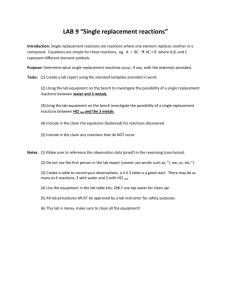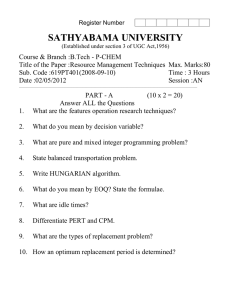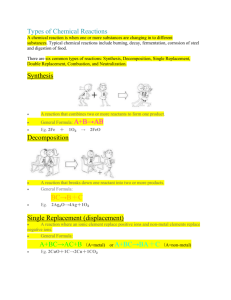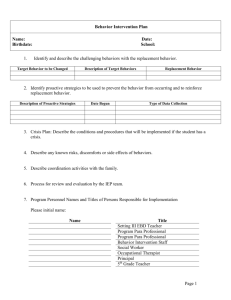UNIT-III 1(a) Write a note on replacement of capital items when
advertisement
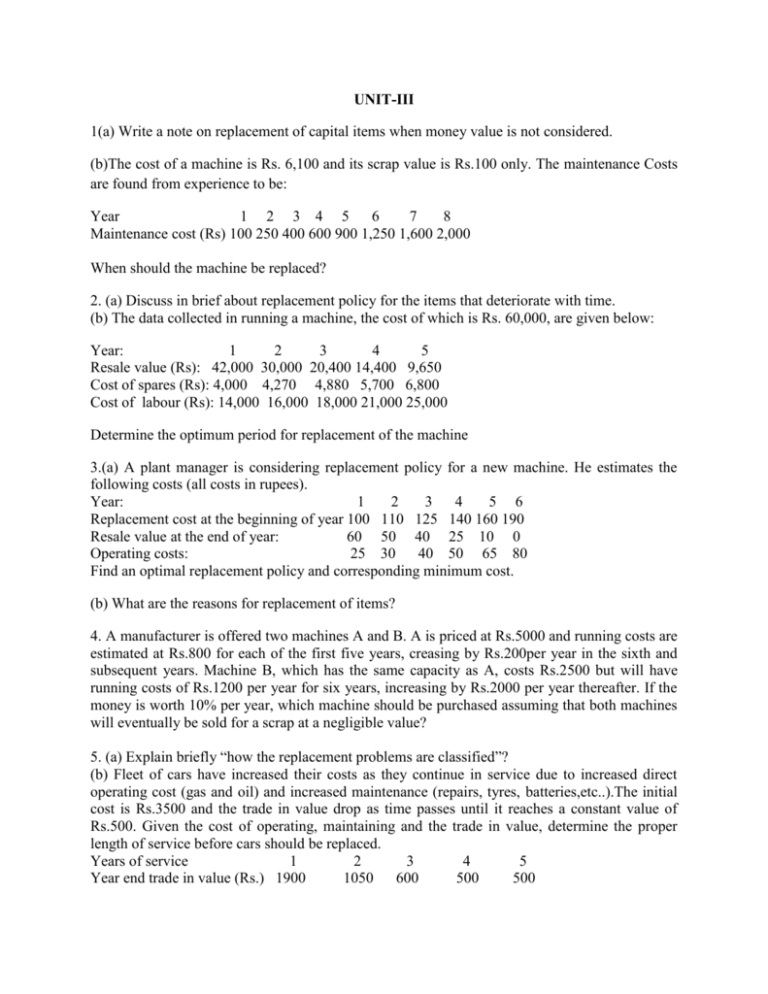
UNIT-III 1(a) Write a note on replacement of capital items when money value is not considered. (b)The cost of a machine is Rs. 6,100 and its scrap value is Rs.100 only. The maintenance Costs are found from experience to be: Year 1 2 3 4 5 6 7 8 Maintenance cost (Rs) 100 250 400 600 900 1,250 1,600 2,000 When should the machine be replaced? 2. (a) Discuss in brief about replacement policy for the items that deteriorate with time. (b) The data collected in running a machine, the cost of which is Rs. 60,000, are given below: Year: 1 2 3 4 5 Resale value (Rs): 42,000 30,000 20,400 14,400 9,650 Cost of spares (Rs): 4,000 4,270 4,880 5,700 6,800 Cost of labour (Rs): 14,000 16,000 18,000 21,000 25,000 Determine the optimum period for replacement of the machine 3.(a) A plant manager is considering replacement policy for a new machine. He estimates the following costs (all costs in rupees). Year: 1 2 3 4 5 6 Replacement cost at the beginning of year 100 110 125 140 160 190 Resale value at the end of year: 60 50 40 25 10 0 Operating costs: 25 30 40 50 65 80 Find an optimal replacement policy and corresponding minimum cost. (b) What are the reasons for replacement of items? 4. A manufacturer is offered two machines A and B. A is priced at Rs.5000 and running costs are estimated at Rs.800 for each of the first five years, creasing by Rs.200per year in the sixth and subsequent years. Machine B, which has the same capacity as A, costs Rs.2500 but will have running costs of Rs.1200 per year for six years, increasing by Rs.2000 per year thereafter. If the money is worth 10% per year, which machine should be purchased assuming that both machines will eventually be sold for a scrap at a negligible value? 5. (a) Explain briefly “how the replacement problems are classified”? (b) Fleet of cars have increased their costs as they continue in service due to increased direct operating cost (gas and oil) and increased maintenance (repairs, tyres, batteries,etc..).The initial cost is Rs.3500 and the trade in value drop as time passes until it reaches a constant value of Rs.500. Given the cost of operating, maintaining and the trade in value, determine the proper length of service before cars should be replaced. Years of service 1 2 3 4 5 Year end trade in value (Rs.) 1900 1050 600 500 500 Annual operating cost (Rs.) Annual maintaining (Rs): 1500 300 1800 400 2100 600 24,000 800 2700 1000 6. There are five jobs each of which must go through the machines A, B and C in the order ABC. The processing times (in hours) are as follows. Jobs 1 2 3 4 5 A 4 3 8 6 5 B 5 6 2 3 4 C 8 10 6 7 11 Machines i. Determine the optimal sequence. ii. What will be the elapsed time? iii. What will be the idle time of the machines? 7. a) What are the assumptions involved in job sequencing problems. (4M) b) There are five jobs, each of which must be processed on the two machines A and B in the Order A- B. Processing time of each job on each machine (in hours) are given below. Job 1 2 3 4 5 Machine A 5 1 9 3 10 Machine B 2 6 7 8 4 Determine optimal sequence for the five jobs that will minimize the elapsed time. Also calculate makespan and idle times of each machine. (6M) 8. (a) What are the conditions for converting 3 machine problem into 2 machine problem? (b)Explain about Johnson’s algorithm. 9. Seven jobs are to be processed on three machines A, B and C in the order ABC and processing times (in hrs) required for the Jobs on the machines are shown below. Determine the optimal sequence of jobs, makespan & Idle times of Machines. Jobs 10. J1 J2 J3 J4 J5 J6 J7 Machines A 3 8 7 4 9 8 7 B 4 3 2 5 1 4 3 C 6 7 5 11 5 6 12 a) How is Johnson’s Algorithm applied to n jobs × 3 machine problem? [5M] b) The processing times of 6 jobs on 3 machines X, Y, Z is given as follows Find the idle times, total elapsed times when the processing order of machines is X Z Y. [5M]



